THE INDIAN POLITY AND GOVERNANCE
1. NO PROPOSAL TO SCRAP SECTION 124A
THE CONTEXT: According to the Ministry of Home Affairs, that there is no proposal under consideration to scrap Section 124A of the Indian Penal Code, 1860. Further, the question of law regarding Section 124A is pending for adjudication before the Supreme Court of India.
THE EXPLANATION:
What is the controversy?
- Recently, the Chief Justice of India made remarks in open court to the Government about the chilling effect of the “colonial law” which suppresses the freedoms of ordinary people.
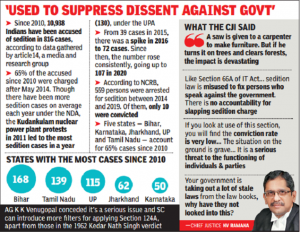
About Sedition Law
- The sedition law, enshrined in Section 124A of IPC, was introduced by the British government in 1870 to tackle dissent against colonial rule.
- The original draft of the IPC, which was enacted in 1860, did not consist of this law and the Section was drafted by Thomas Babington Macaulay in 1970.
Section 124A states:
- “Whoever, words, either spoken or written, or by signs, or by visible representation, or otherwise, brings or attempts to bring into hatred or contempt, or excites or attempts to excite disaffection towards the Government established by law in India shall be punished with imprisonment for life, to which fine may be added, or with imprisonment which may extend to three years, to which fine may be added, or with fine.”
- In the 19th and 20th centuries, the law was used primarily to suppress the writings and speeches of prominent Indian nationalists and freedom fighters.
- The first known instance of the application of the law was the trial of newspaper editor Jogendra Chandra Bose in 1891.
- Other major examples of the application of the law include the trials of Bal Gangadhar Tilak, Mahatma Gandhi, Jawaharlal Nehru, Abul Kalam Azad and Vinayak Damodar Savarkar.
Trials of Tilak and Gandhi
- In 1922, Gandhi was arrested on charges of sedition in Bombay for taking part in protests against the colonial government and was sentenced to six years in prison. However, he was released after two years because of medical reasons.
- Tilak faced three trials in cases related to sedition and was imprisoned twice. In 1897, he was charged with sedition for writing an article in his weekly publication called Kesari and was sentenced to 12 months imprisonment. In 1908, he was tried again for his writings and was represented by Mohammad Ali Jinnah.
Arguments For Section 124A
- Section 124A of the IPC has its utility in combating anti-national, secessionist and terrorist elements.
- It protects the elected government from attempts to overthrow the government with violence and illegal means.
- The continued existence of the government established by law is an essential condition of the stability of the State.
- Many districts in different states face a Maoist insurgency and rebel groups virtually run a parallel administration.
- These groups openly advocate the overthrow of the state government by revolution.
- Therefore, there is a need to retain the provision to effectively combat anti-national, secessionist and terrorist elements.
- The plea had contended that the provision which was used by the British against Mahatma Gandhi and Bal Gangadhar Tilak is still being “grossly abused” to stifle freedom of speech and expression of those who choose to express dissent against policies of the Governments in power
Arguments Against Section 124A
- Mahatma Gandhi called Section 124A “the prince among the political sections of the IPC designed to suppress the liberty of the citizen”.
- Jawaharlal Nehru said that the provision was “obnoxious” and “highly objectionable”, and “the sooner we get rid of it the better”.
- It is a constraint on the legitimate exercise of constitutionally guaranteed freedom of speech and expression.
- Dissent and criticism of the government are essential ingredients of robust public debate in a vibrant democracy.
- The British, who introduced sedition to oppress Indians, have themselves abolished the law in their country. There is no reason why India should not abolish this section.
- The sedition law is being misused as a tool to persecute political dissent. A wide and concentrated executive discretion is inbuilt into it which permits the blatant abuse.
Supreme Court’s Earlier Stand
- The sedition law has been challenged several times over the last few years but it has managed to survive all of the challenges against it.
- In the landmark Kedar Nath versus Union of India case (1962), the SC upheld the constitutional validity of the sedition law while trying to curtail its misuse.
- The Court upheld the law on the basis that this power was required by the state to protect itself.
- However, it had added a vital caveat that “a person could be prosecuted for sedition only if his acts caused incitement to violence or intention or tendency to create public disorder or cause disturbance of public peace”.
- It also added that unless accompanied by incitement or call for violence, criticism of the government cannot be labelled sedition.
- The SC laid down that every citizen has a right to say or write about the government, by way of criticism or comment, as long as it does not “incite people to violence” against the government established by law or with the intention of creating public disorder.
- In September 2016, the SC had reiterated these necessary safeguards and held that they should be followed by all authorities.
2. THE GOVERNOR’S ROLE IN STATE, CENTRAL UNIVERSITIES
THE CONTEXT: A controversy has erupted in Kerala over the reappointment of Vice Chancellor of Kannur University, with Kerala Governor saying he approved the decision against his “better judgement” as Chancellor. In a letter to Chief Minister, Governor expressed his desire to step down as Chancellor, alleging political interference in the universities.
What is the role of Governors in state universities?
- In most cases, the Governor of the state is the ex-officio chancellor of the universities in that state. While the Governor’s powers and functions as the Chancellor are laid out in the statutes that govern the universities under a particular state government, their role in appointing the Vice Chancellors has often triggered disputes with the political executive.
- In Kerala’s case, the Governor’s official portal asserts that “while as Governor he functions with the aid and advice of the Council of Ministers, as Chancellor he acts independently of the Council of Ministers and takes his own decisions on all University matters”. In marked contrast, the website of Rajasthan’s Raj Bhawan states that the “Governor appoints the Vice Chancellor on the advice/ in consultation with the State Government”.
What about central universities?
- Under the Central Universities Act, 2009, and other statutes, the President of India shall be the Visitor of a central university. With their role limited to presiding over convocations, Chancellors in central universities are titular heads, who are appointed by the President in his capacity as Visitor.
- The VCs too are appointed by the Visitor from panels of names picked by search and selection committees formed by the Union government. The Act adds that the President, as Visitor, shall have the right to authorize inspections of academic and non-academic aspects of the universities and also to institute inquiries.
THE INTERNATIONAL RELATIONS
3. THE INDO-SRILANKA ACCORD OF 1987
THE CONTEXT: A group of Opposition MPs in Sri Lanka, representing Tamils from the north and east, hill country (Malaiyaha Tamils), and Tamil-speaking Muslims sought the full implementation of the 13th Amendment to ensure “existing rights are not snatched away”.
THE EXPLANATION:
What is the Accord?
- Popularly referred to as the Rajiv-Jayewardene Accord, after its architects Prime Minister Rajiv Gandhi and President J.R. Jayewardene.
- It sought to collectively address all the three contentious issues between India and Sri Lanka: strategic interests, people of Indian origin in Sri Lanka and Tamil minority rights in Sri Lanka.
- This accord saw the induction of the Indian Peace Keeping Force (IPKF) in Sri Lanka.
- According to the terms of the accord, Sri Lankan forces would withdraw from the north and the Tamil rebels would disarm.
- The accord was expected to resolve the Sri Lankan Civil War by enabling the thirteenth Amendment to the Constitution of Sri Lanka and the Provincial Councils Act of 1987.

Why the 13th Amendment contentious?
- As per the 13th amendment, Sri Lanka was divided into nine provinces each governed by a council headed by an elected chief minister.
- The north and east was merged into one province called North-East province. Also, Tamil was made an official language along with the Sinhalese. The powers were divided into three lists viz. Provincial, Reserved and Concurrent.
- However, since all the provisions of 13th amendment were not implemented, it is called 13-Minus. 13 Minus implies that Police, Land and Financial powers have not been devolved. The provinces have struggled to get adequate financial powers. Then in 2007, the North and East were demerged. This was followed by more centralized powers in the hands of President, eroding whatsoever autonomy was with the provinces.
- Before LTTE was decimated, the Sri Lankan government was ready to go well beyond what was promised in 13th amendment, but then LTTE rejected it. In 2006, the then President Rajapaksha had appointed an All Party Representative Committee (APRC) in April 2006 to design a solution which looks good and reasonable enough to address the concerns in the aftermath of LTTE end.
- This committee recommended in 2008 about full implementation of 13th amendment along with creation of a second house. However, once LTTE decimated, implementing 13 itself has hit a roadblock.
- Further, when former President Rajapaksha met Indian Prime Minister, and said that devolving police powers would be “risky and difficult”, thus putting more suspense to the 13th amendment story.
Stance of India
India has always emphasised on a meaningful devolution package, based on the 13th Amendment. India’s interest is not only cultural but also demographic as around 1 lakh Tamil refugees are living in India. Until a political reconciliation is achieved in Sri Lanka, return of these refugees will not be possible.
4. NEW CALEDONIA VOTES TO REMAIN A FRENCH TERRITORY
THE CONTEXT: Voters in the French island territory of New Caledonia chose overwhelmingly to stay part of France, in a referendum boycotted by pro-independence forces.
THE EXPLANATION:
- The vote was the third and last in a decades-long decolonization process that stemmed from violence in 1988, which led to the French government handing New Caledonia broad autonomy under the Noumea Agreement.
- The official results showed 96% of those who took part chose to stay in France. Overall turnout was just 42% — less than half the numbers who showed up in a previous independence referendum last year, where support for breaking away was 46.7%.
- The vote was monitored by the U.N. and regional powers, amid global efforts toward decolonization and amid growing Chinese influence in the region. New Caledonia, colonized by Napoleon’s nephew in the 19th century, is a vast archipelago of about 270,000 people east of Australia that is 10 time zones ahead of Paris — and hosts a French military base.
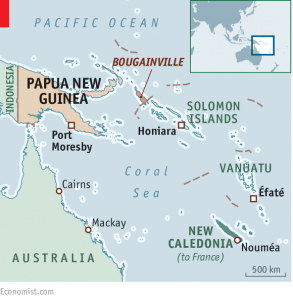
BACKGROUND:
- In the first such referendum in 2018, 43.6% of voters supported independence, and 46.7% favoured it in a second vote held in 2020. While support for a “yes” vote seemed to be growing, the region’s first coronavirus outbreak in September threw the political debate into disarray. Until then, New Caledonia had been one of the few virus-free places left on the planet.
- France is trying to cement its presence in the Indo-Pacific region after it lost a multibillion-dollar submarine contract because of a partnership Australia formed with the United States and the U.K. The secretly negotiated submarine project, announced in September and aimed at countering Chinese ambitions in the region, was a huge blow to France. New Caledonia hosts one of two French military bases in the Pacific.
New Caledonia
- It is an archipelago.
- It is located in the southwest Pacific Ocean.
- It was discovered in 1774 by the British navigator James Cook.
- It was annexed by France in 1853.
- In 1946, it became an overseas territory.
- By 1953, French citizenship had been granted to all New Caledonians, regardless of ethnicity.
- It accounts for around 10% of the world’s nickel reserve.
French Overseas Territories:
- The Islands of Guadeloupe, Martinique, Saint-Martin, Saint-Barthélemy, Saint Pierre and Miquelon (Atlantic Ocean)
- Reunion island, Mayotte, the French Southern and Antarctic Lands (Indian Ocean)
- French Polynesia, New Caledonia, Wallis and Futuna (Pacific Ocean)
The French Overseas Territories cover almost 120 000 km² and are home to more than 2.6 million people.
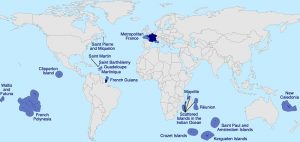
THE ENVIRONMENT AND ECOLOGY
5. ROYAL BENGAL TIGER SIGHTED AT BUXA RESERVE
THE CONTEXT: A camera trap set up at Buxa Tiger Reserve (BTR) in Alipurduar district of West Bengal have captured a sight of Royal Bengal Tiger, that the region has not witnessed in more than two decades.
THE EXPLANATION:
- According to the state forest officials of Buxa Tiger Reserve, there is an improve within the forest density and the large cat prey base, particularly deer, had attracted a Royal Bengal tiger, a primary such sighting in 23 years.
- The favourable habitat at the tiger reserve would invite more tigers, which had migrated to neighbouring Bhutan. The state shares a contiguous range of the protected area with Bhutan.
- The forest department has of late relentlessly tried to increase the density of the jungle. A herd of deer was introduced to the forest so that tigers could find their food from the jungle. The movement of human beings was restricted specially in the core tiger reserve. These measures led to the success. As a result, tigers are now returning from Bhutan.
- In 2020, the report released by the Union Ministry of Environment, Forests and Climate Change said the ‘Buxa reserve had no tiger, and its infrastructure was found wanting. “Buxa needs to be rebuilt as a tiger habitat. Tigers may have been brought from Kaziranga.
About Buxa Tiger Reserve:
- Located in Northern West Bengal, India
- Located in the Buxa Hills of the southern hilly area of Bhutan.
- Its northern boundary runs along the international border with Bhutan
- Animals found -Royal Bengal Tiger, civet, elephant, gaur (Indian bison), Indian boar and red jungle fowl
- The fragile “Terai Eco-System” constitutes a part of this reserve.
- The Phipsu Wildlife Sanctuary of Bhutan is contiguous to the north of BTR.
- Tiger reserve located inside the Buxa National Park.
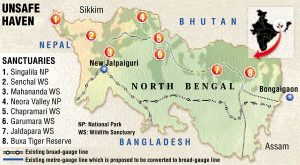
The Royal Bengal Tiger:
The Royal Bengal Tiger belongs to specific population of the Panthera tigris tigris subspecies, which is native to the Indian subcontinent. The tiger is threatened by poaching and fragmentation of habitat. India’s tiger population was 2,967 in 2019. 300–500 tigers are found in Bangladesh, 220–274 in Nepal while 103 tigers in Bhutan. In the red list of IUCN, it has been list into Endangered category.
6. WORLD’S ONLY BREEDING CENTRE FOR ASIATIC LIONS
THE CONTEXT: Recently, Sakkarbaug zoo of Junagadh in Gujarat as three of its Asiatic lionesses have given birth to 13 cubs.
THE EXPLANATION:
The Sakkarbaug Zoological Garden is a 210-acre facility that provides pure-bred Asiatic lions for the Indian and international endangered species captive-breeding programme. Wild, free-ranging Asiatic lions have become extinct in most parts of Asia and are now found only in and around the Gir Forest.
However, it is important to note that, Sakkarbaug Zoo of Junagadh is the only breeding centre in the world for Asiatic lions, and the Gir Forest, the Asiatic lion population went to 674 in 2020.”
ABOUT ASIATIC LION:
- It is one of five big cat species found in India and Gir National Park and Wildlife Sanctuary is the only habitat for Asiatic lions.
- Historically, it inhabited much of Western Asia and the Middle East up to northern India.
- More than two dozen lions died in an outbreak of canine distemper virus (CDV) and Babesiosis.
Conservation Status:
- IUCN Red List: Endangered
- CITES: Appendix I
- Wildlife (Protection) Act 1972: Schedule I
Factors responsible for steady rise in population:
Over the last several years, the lion population in Gujarat has been steadily rising.
This is powered by:
- community participation
- emphasis on technology
- wildlife healthcare
- proper habitat management
- steps to minimise human-lion conflict.
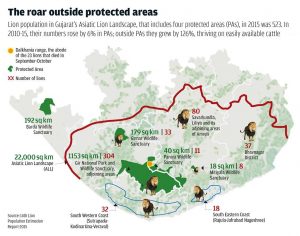
7. ILLEGAL TRADE OF WILD ANIMALS
THE CONTEXT: According to the Ministry of Environment, forest, and climate change, between 2018 and 2020, about 2,054 cases were registered for killing or illegal trafficking of wild animals in India.
THE EXPLANATION:
- In the three years, about 3,836 accused were arrested for the crime. The number of cases registered in the year 2018 was 648 and 1,099 persons were arrested; followed by 805 cases and 1,506 arrests in 2019; and 601 cases and 1,231 arrests in 2020.
- The WCCB (Wildlife Crime Control Bureau) had launched operation “Save Kurma” from to December 2016 to January 2017 to focus on the poaching, transportation and illegal trade of live turtles and tortoises. The operation resulted in seizure of more than 15,912 live turtles and the arrest of 55 suspects.
- Another operation “Operation Turtshield- I” from December 2019 to January 2020 and Operation Turtshield-II” (December 2020 to February 2021) was taken up to tackle the illegal trade of live turtles, resulting in the seizure of 4,601 live/dead turtles and arrest of 45 accused in the first operation.
- In the second operation, 59 accused were arrested and the efforts led to the recovery of 11,771 live turtles/tortoises and 45 kilograms of turtle calipee.
- “Operation Softgold” was undertaken from October 2018 to March, 2019 to tackle illegal trade in Shahtoosh shawls (made from Chiru wool). During the operation, 350 shawls were found.
About Wildlife Crime Control Bureau:
- Considering the seriousness of organised Wildlife Crime and illegal trade of wildlife parts and products, the Wildlife Crime Control Bureau was created in 2007 under the provisions of the Wildlife Protection Act 1972.
- Wildlife Crime Control Bureau is designated nodal agency for CITES related enforcement.
- WCCB is a statutory multi-disciplinary body under the MoEFCC.
Under the Wildlife (Protection) Act, 1972, WCCB is mandated to
- collect and collate intelligence related to organized wildlife crime.
- disseminate the same to State and other enforcement agencies to apprehend the criminals.
- to establish a centralized wildlife crime data bank.
- co-ordinate actions by various agencies in connection with the enforcement of the provisions of the Act.
- assist international organizations & foreign authorities to facilitate wildlife crime control.
- capacity building of the wildlife crime enforcement agencies.
- assist State Governments to ensure success in prosecutions related to wildlife crimes; and
- advise the Government of India on issues relating to wildlife crimes.
- It also assists and advises the Customs authorities in inspection of the consignments of flora & fauna as per the provisions of Wildlife Protection Act, CITES and EXIM Policy governing such an item.
THE SCIENCE AND TECHNOLOGY
8. PINAKA ROCKET SYSTEM
THE CONTEXT: “The DRDO, along with the Army, conducted a series of performance evaluation trials. In these trials, enhanced range Pinaka rockets were test-fired at different ranges with various warhead capabilities. All the trial objectives were met satisfactorily. 24 rockets were fired for different ranges and warhead capabilities to meet the objectives of accuracy and consistency.”
THE EXPLANATION:
Also stated with this, the initial phase of technology absorption of the Pinaka-ER (Enhanced Range) by the industry partner has successfully been completed, making the upgraded rocket system ready for production.
What is Pinaka-ER?
The Pinaka-ER is the upgraded version of the earlier Pinaka, which has been in service with the Indian Army for the last decade. The system has been designed in light of emerging requirements with advanced technologies. The extended range of the new Pinaka is over 70 km, as opposed to the 45 km the system currently has.
About Pinaka Rocket System:
- Pinaka is an all-weather, artillery multi-barrel rocket system. It can fire 72 rockets in 44 seconds. It delivers lethal and responsive fire against a variety of area targets such as exposed enemy troops, armoured and soft skin vehicles, communication centres, air terminal complexes, fuel and ammunition dumps.
- The Pinaka gives a deep strike option to the forces on the ground and is capable of hitting critical military installations.
- The Pinaka rocket system was recently deployed at the China border amid tensions that began in Ladakh.
- The system was jointly designed by laboratories of Defence Research and Development Organisation (DRDO) – Armament Research & Development Establishment (ARDE), Pune and High Energy Materials Research Laboratory (HEMRL), Pune.
- The Area Denial Munition (ADM) variants designed by ARDE and manufactured by industry partners under technology transfer were successfully carried out at Pokhran Field Firing Ranges. These trials are part of performance evaluation under technology absorption.
- The indigenously developed proximity fuses for Pinaka rockets have also been tested.
- The initial version of weapon system was called Mark I, which had a range of 40 km. The upgraded version or Pinaka Mark II has an extended range of 70 to 80 km.
9. AI TOOL TO SIMPLIFY IDENTIFICATION OF CANCEROUS TISSUE IN TUMOURS
THE CONTEXT: IIT Madras researchers developed this tool using deep learning and traditional machine learning to develop a tool that can diagnose cancer by looking at whole slide images of the tumour. The tool has been tested on datasets of breast, liver and colon cancer tissue images.
THE EXPLANATION:
Digital histopathology
- Traditionally, histopathologists slice the tumour tissue into approximately 20-micron-thick slices which they put on slides. They look at enlarged images of the slides and go over it cell by cell to manually classify it as cancerous or otherwise. This is highly time-consuming, and it is to alleviate this burden that digital histopathology developed.
- In this, after preparing the slides, the entire slide is scanned using a high-resolution microscope and digitised. This is then analysed using computerised tools.This digital process has its own challenges. The first of this is the sheer size of the scanned images which can run into gigabytes.
- A single image could be 100,000 by 100,000 pixels large – compare this with a shot generated by a smart phone which is about 7,000 by 7,000 pixels in size,” says Ganapathy Krishnamurthy of the Engineering Design Department of IIT Madras in an email, giving an idea of the challenge to computer time posed by this task.
- The technique posed further challenges, such as insufficient training data and the variation in staining across labs.
- Also extracting clinically relevant information, that is, directly inferring fine-grained disease classification using deep learning alone was turning out to be prohibitively expensive in terms of computational time.
Algorithms:
To test the algorithms, the researchers enrolled in three open challenges – the CAMELYON17 challenge, the DIGESTPATH 2019 challenge and the PAIP 2019 challenge. “This paper takes data from three different challenges. In two of these, we were placed in the top 3 performing methods and in one challenge (CAMELYON) we were placed in the top 10 out of several hundred entries.
THE PRELIM PRACTICE QUESTION
Q1. Which of the following pairs of French overseas territory is incorrectly matched?
- French Polynesia – Atlantic Ocean
- New Caledonia – Pacific Ocean
- Reunion island – Indian Ocean
Select the correct answer using codes given below?
a) 1 only b) 1 and 2
c) 2 and 3 d) 1, 2 and 3
ANSWER FOR 11TH DECEMBER 2021 PRELIMS PRACTICE QUESTIONS
Answer: a)
Explanation:
- Statement 1 is correct: The ISA was conceived as a joint effort by India and France to mobilise efforts against climate change through the deployment of solar energy solutions.
- Statement 2 is correct: Its headquarter is located in Gurugram, Haryana.
- Statement 3 is incorrect: Countries that do not fall within the Tropics can join the alliance and enjoy all benefits as other members, with the exception of voting rights.


